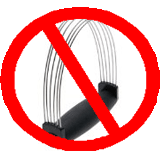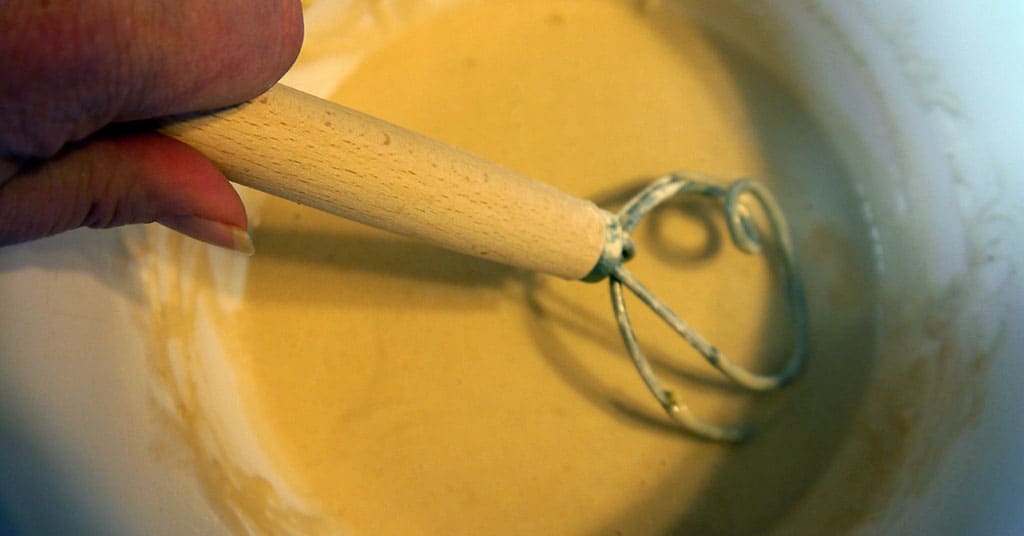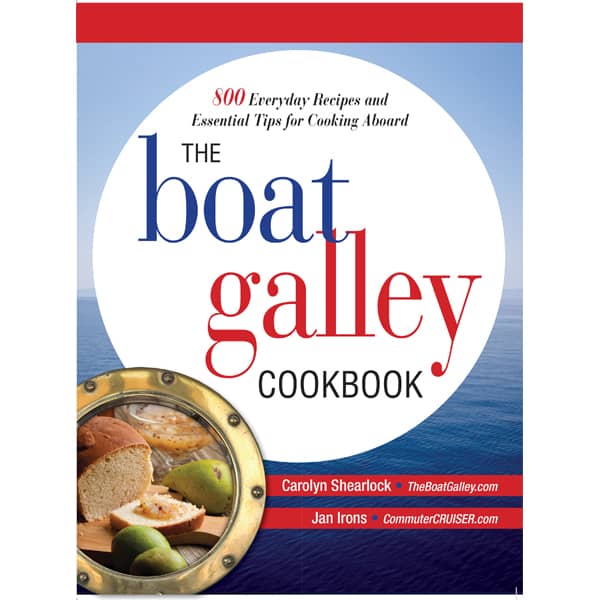Baking, in most boat galleys, means using a mixing spoon or maybe a whisk. No electric mixer, blender, food processor or bread machine! YIKES! Is it even possible to make baked goods and other treats without these? Of course! Our grandmothers (or maybe great grandmothers, depending on your age) did it. I’ve done it for years. The right tools help.
Still, it’s not easy to search out tools that are truly designed for hand mixing. Many serve as only an adjunct to electric mixers. Below, you can see my picks. And I’ll tell you why these items are particularly suited for hand mixing. Except where otherwise noted, the links are to Amazon.
By the way, when I lived on land between boats, I found that I almost never used my electric beater or blender. Since I’ve got the tools for easy hand mixing, I just do things by hand. There’s less to clean up. I use less electricity. And it’s good exercise.
Hand Mixing Bowl
For hand mixing, you need a bowl that’s designed to be gripped in your hand, not one designed to be used with an electric mixer. For mixing up cakes, cookies, brownies and the like, my favorite is the OXO Batter Bowl.
The batter bowl features a non-slip bottom and a handle to hold while mixing. Both keep it from sliding around. Actually, on boats I like non-slip bottom surfaces on everything. That means there’s less chance of something spilling when I’m not holding it at the exact moment the boat moves. The pour spout also helps when you transfer the batter to a pan. Additionally, it’s made of a high-quality plastic. That makes it less likely to break. And it won’t make noise when stowed, even on a rough passage. It’s a 2-quart bowl.
If you prefer a set of bowls that includes a larger 5-quart size (and you have room to store it), Oxo offers a similar 3-bowl set. Again all bowls suit hand mixing. Instead of a handle, these have a wide lip on one side to grab onto. They also feature the same non-slip bottom and pour spout. If you like to tuck your mixing bowl under your arm, sort of on your hip, as you’re beating batter, these bowls are perfect. The set includes a 1-1/2 quart, 3 quart and 5 quart bowl, each of which can also be purchased individually.
Mixing Spoon
I’ll admit to being spoiled when it comes to my mixing spoon. I have two sterling silver hand mixing spoons that my family have passed down from my great grandmother. I love them. When I recently wanted to buy a hand mixing spoon for a granddaughter, I discovered that they are hard to find now.
Most items sold as “mixing spoons” are wooden. But wooden spoons aren’t really designed for mixing heavy batters and doughs. And trying to hold one can get tiring. With heavy doughs, wooden spoons are also likely to split. So if you do use one, be sure that it’s a sturdy one.
The other popular materials out there are silicone and nylon. Nylon spoons simply aren’t stiff enough to mix heavy dough. The handle either bends too much or actually breaks. And silicone spoons are actually silicone over a thin metal core. Again they just aren’t designed for mixing heavy batter (although they are great for stirring items on the stove). So I don’t recommend them.
What I do recommend are stainless steel spoons. And I prefer ones that don’t have round handles. It’s hard to get a good grip on a round handle to keep it from twisting around as you mix thick batter. I also like one that’s 8 to 10 inches long. Using a longer spoon in any sort of thick dough is just too tiring to keep a good grip on the handle. And if you “choke down” on the handle, you end up trying to get a grip on a narrower portion of the handle. That also becomes tiring on your hand.
I strongly prefer one-piece construction, as connection points are very likely to fail with the stresses of mixing heavier doughs and batters. And joints are places for bacteria to breed.
I have looked all over the internet for what I’d consider the perfect hand mixing spoon and haven’t found the ideal one yet. This one is close, although I wish it had a more ergonomically designed handle (similar to the OXO whisks, below):
Standard Whisks
Whisks aren’t 100% essential for hand mixing in a boat galley. You can usually use a fork if you don’t have a whisk. But for beating larger quantities of lightweight things, a whisk makes the job so much easier.
I really like these 11″ and 9″ stainless whisks with ergonomic handles from OXO. And the set of 5″ and 7″ stainless mini-whisks are handy for smaller quantities. If you’re really pressed for storage space, I’d chose the 9″ whisk as being a good all-around size.
- Oxo Good Grips 11-Inch Balloon Whisk
- Oxo Good Grips 9-Inch Whisk
- RSVP International Endurance Mini Whisk Set
Danish Dough Whisk
Despite being called a “whisk,” it’s nothing like the whisks that you’re probably more familiar with. Yes, it’s made of wire, but it’s a very heavy wire that doesn’t bend or give even with very heavy doughs.
It’s advertised for making bread, and it’s great for that. But it’s also wonderful for hand-mixing any sort of dough — cakes, cookies, brownies, coffee cake and so on. I’ve used it for all of those and it’s now my “go-to” mixing spoon. Yes, I usually grab it instead of my great-grandmother’s mixing spoon that I’ve used since I was a child.
It’s extremely sturdy and is less tiring on my arm than a regular spoon when mixing heavy doughs. It also does a better job of beating in eggs “until light and fluffy” than a spoon. The only thing that I still prefer a spoon for is creaming butter (or shortening) and sugar. Then I switch to using the dough whisk for the rest of the mixing.
There’s both an 11-inch and a 14-inch dough whisk. The 11-inch is a FAR better size. I can’t imagine using anything larger with a “normal sized” mixing bowl. Where I live, they’re not available in local stores but they are available on Amazon (Prime members get free shipping):
The only drawback to the whisk is that it can be a little harder to clean than a stainless steel spoon. To me, it’s a worthwhile trade-off for the better mixing ability.
For me, this is one tool that earns its space in a tiny kitchen!
Rotary Egg Beater
I don’t personally use a rotary egg beater. But several cruisers suggest them as a good option.
The one downside I see is that they take more room to store than any other mixing “spoon.” But if you have the space, they might be worth a try. I also imagine they might be easier for people with limited hand strength.
Silicone Scraper
Once you’ve made that fantastic batter, you want to get every bit out of the bowl and into the pan. I really like the hand-held bench scraper. I find it’s easier to hold than one with a handle. It’s bigger than you’d guess, not one of those little bitty ones. And the curved side nicely scrapes out bowls, while the straight side is good for cleaning up messes on the counter or in a pan.
If you prefer a scraper with a handle, the one-piece silicone ones are a much better choice than ones that have a joint between the handle and the scraper. That joint is likely to break and will harbor bacteria from little bits of raw batter and dough that get in there. My choice:
NOTE: While they call this a “spoon spatula” don’t think that you can use it as a substitute for a true mixing spoon. It’s just not strong enough for long-term use.
Pastry Blender
A pastry blender isn’t just for pastry. I find it really useful for things like crushing fruit and “blending” hard butter, margarine or cream cheese to soften it faster. It also works well to chop up hardboiled eggs for egg salad, or the yolks to make deviled eggs. But if you’re really hurting for storage space, you can make do with other tools, such as using two knives to mix the flour and shortening for a pie crust or a sharp knife to do some of the other chopping chores.

But since I have a pastry blender, I find I use it frequently. And I’ve learned that there are two basic styles, one that works well and one that doesn’t. You guessed it, the one with the red circle and slash is the one I don’t like. In use, those little wires just spread out from each other when they meet any resistance, instead of cutting through the food. Using one is simply an exercise in frustration and you’ll end up getting out a knife or fork to finish the job.
The blender with solid sides, is the style you want. I’ve never seen one with sharp blades (which would make the job easier), so you don’t have to take any special precautions in storing it. A small nail brush will help to clean between the blades when hand washing.
For tips on using your new equipment, see my article on 3 Keys to Easier Hand Mixing. By the way, having the right equipment is number one!
It’s also helpful to have recipes that are designed for hand mixing — and almost all of them in The Boat Galley Cookbook are!
Related Posts

Carolyn Shearlock has lived aboard full-time for 17 years, splitting her time between a Tayana 37 monohull and a Gemini 105 catamaran. She’s cruised over 14,000 miles, from Pacific Mexico and Central America to Florida and the Bahamas, gaining firsthand experience with the joys and challenges of life on the water.
Through The Boat Galley, Carolyn has helped thousands of people explore, prepare for, and enjoy life afloat. She shares her expertise as an instructor at Cruisers University, in leading boating publications, and through her bestselling book, The Boat Galley Cookbook. She is passionate about helping others embark on their liveaboard journey—making life on the water simpler, safer, and more enjoyable.
Simplify meal prep on board with proven strategies for provisioning, maximizing fridge space, and cooking delicious meals aboard your boat.










Carolyn Shearlock says
Good Kindle “reference” books (including cookbooks) should have a linked subject index, but admittedly not all do. Many times, if you read the reviews on a particular title, someone will mention whether or not the Kindle version has a linked index.
You can also use the search feature in Kindle although it’s not exactly the same as using the index in the back of a book.
The Boat Galley says
Great story — I was the same way when we moved back ashore for a bit . . . never bothered to use the mixer!